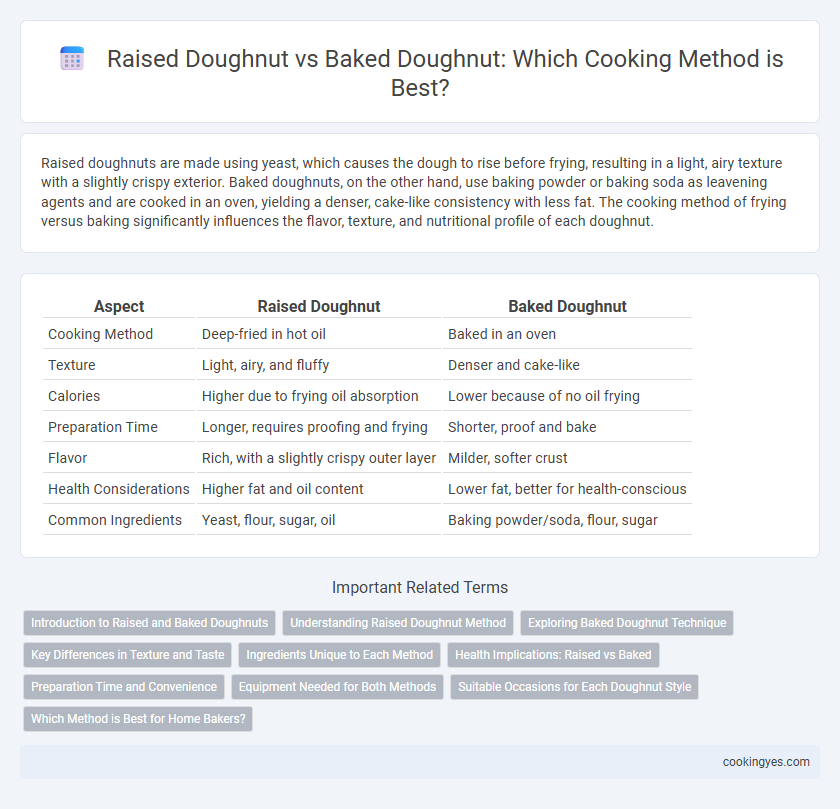Raised doughnuts are made using yeast, which causes the dough to rise before frying, resulting in a light, airy texture with a slightly crispy exterior. Baked doughnuts, on the other hand, use baking powder or baking soda as leavening agents and are cooked in an oven, yielding a denser, cake-like consistency with less fat. The cooking method of frying versus baking significantly influences the flavor, texture, and nutritional profile of each doughnut.
Table of Comparison
| Aspect | Raised Doughnut | Baked Doughnut |
|---|---|---|
| Cooking Method | Deep-fried in hot oil | Baked in an oven |
| Texture | Light, airy, and fluffy | Denser and cake-like |
| Calories | Higher due to frying oil absorption | Lower because of no oil frying |
| Preparation Time | Longer, requires proofing and frying | Shorter, proof and bake |
| Flavor | Rich, with a slightly crispy outer layer | Milder, softer crust |
| Health Considerations | Higher fat and oil content | Lower fat, better for health-conscious |
| Common Ingredients | Yeast, flour, sugar, oil | Baking powder/soda, flour, sugar |
Introduction to Raised and Baked Doughnuts
Raised doughnuts are made from yeast-leavened dough that is deep-fried, resulting in a light, airy texture with a crisp exterior. Baked doughnuts use cake-like batter, cooked in an oven, producing a denser, moist crumb with less fat content. Comparing cooking methods, raised doughnuts offer a classic fluffy bite while baked doughnuts provide a healthier alternative with a different texture profile.
Understanding Raised Doughnut Method
Raised doughnuts undergo fermentation with yeast, resulting in a light, airy texture and a slightly tangy flavor due to the gluten development and carbon dioxide production. The dough is proofed before frying, which expands the doughnut and creates characteristic pockets of air. This method contrasts with baked doughnuts, which use chemical leavening agents like baking powder, producing a denser texture without the complex flavor profile from yeast fermentation.
Exploring Baked Doughnut Technique
Baked doughnuts offer a healthier alternative to raised doughnuts by using oven baking instead of deep frying, significantly reducing oil absorption and calorie content. The baking technique preserves a light, fluffy texture by incorporating baking powder or baking soda as leavening agents, unlike yeast-based raised doughnuts that require fermentation and frying. This method streamlines preparation time and lowers fat content, making baked doughnuts a convenient and nutritious choice without sacrificing classic doughnut flavor.
Key Differences in Texture and Taste
Raised doughnuts are fried, resulting in a light, airy texture with a slightly crispy exterior and a rich, indulgent flavor due to the oil cooking process. Baked doughnuts have a denser, cake-like texture with a softer crust and a less greasy taste, making them a healthier alternative with a subtle sweetness. The cooking method directly influences moisture retention and crumb structure, creating distinct taste and mouthfeel experiences between raised and baked doughnuts.
Ingredients Unique to Each Method
Raised doughnuts rely on yeast as a leavening agent, which requires fermentation to develop their light and airy texture, while baked doughnuts often use chemical leaveners like baking powder for a quicker preparation. Raised doughnut recipes commonly include milk, sugar, and eggs to support yeast activity and enhance flavor, whereas baked doughnuts may incorporate yogurt or sour cream to maintain moisture without yeast. The presence of yeast in raised doughnuts also influences the dough's elasticity and rise time, setting it apart from the denser batter typical in baked doughnuts.
Health Implications: Raised vs Baked
Raised doughnuts are traditionally deep-fried, resulting in higher calorie content and increased levels of unhealthy trans fats, which can contribute to cardiovascular issues. Baked doughnuts use an oven-based cooking method that significantly reduces oil absorption, offering lower fat and calorie levels, making them a healthier alternative for weight management and heart health. Choosing baked over raised doughnuts can decrease saturated fat intake and promote better overall nutritional profiles.
Preparation Time and Convenience
Raised doughnuts typically require longer preparation time due to the need for yeast fermentation and proofing, which can take several hours. Baked doughnuts offer greater convenience with quicker preparation, as the batter can be mixed and baked within 30 to 40 minutes without waiting for dough to rise. Home cooks and commercial bakeries often prefer baked doughnuts for faster turnaround and easier cleanup compared to the frying process of raised doughnuts.
Equipment Needed for Both Methods
Raised doughnuts require deep-frying equipment such as a heavy-duty fryer or a large, deep pot with a thermometer to maintain oil temperature and ensure even cooking. Baked doughnuts are made using a doughnut pan and a standard oven, making them more accessible for home baking without specialized frying tools. Both methods need precise temperature control, but raised doughnuts demand more safety precautions due to hot oil handling.
Suitable Occasions for Each Doughnut Style
Raised doughnuts, known for their light, airy texture achieved through deep-frying, are ideal for festive occasions and celebrations where indulgence and traditional flavors are desired. Baked doughnuts, offering a healthier alternative with less oil and a cake-like consistency, are perfect for casual gatherings and breakfast events focused on lighter treats. Both styles provide versatility, with raised doughnuts excelling in flavor impact and baked doughnuts fitting well into health-conscious menus.
Which Method is Best for Home Bakers?
Raised doughnuts offer a light, airy texture achieved through yeast fermentation and deep frying, delivering a classic, crispy exterior with a tender crumb. Baked doughnuts provide a healthier alternative by using an oven, resulting in a denser, cake-like texture with less fat and easier preparation. Home bakers seeking traditional flavor and texture often prefer raised doughnuts, while those prioritizing convenience and lower fat content may find baked doughnuts the better choice.
Raised doughnut vs Baked doughnut for cooking method Infographic

 cookingyes.com
cookingyes.com